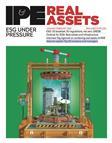Danish pension fund ATP is content to halt investments in real assets while valuations remain at their current high level, according to its chief executive.
Carsten Stendevad, chief executive of the DKK770bn (€103bn) pension fund, told IP Real Estate: “If we can find more of these assets we would love to get them, but if we didn’t find a single real asset in the next two years because prices were unattractive, that’s fine also.”
Stendevad was referring to real assets it recently moved from its hedge portfolio — which underpins pension promises and constitutes the majority of ATP’s holdings — from its smaller investment portfolio which contributions towards its bonus reserves.
With effect from January this year, ATP made changes to its pension guarantee structure, effectively shortening the length of each new yield guarantee from life to consecutive 15-year periods.
“If the risk-adjusted return in real estate is better than it is in infrastructure, then we’ll do real estate. If next year it’s the other way around, then we’ll do infrastructure.”
Carsten Stendevad
This move followed a change the pension fund had made the previous October, in implementing a new 3% discount curve for maturities of 40 years or more which had the effect of reducing its sensitivity to interest rates by 25%.
Having been made up solely of long-dated German and Danish government bond and related instruments, the hedge portfolio can now also contain real assets such as property and infrastructure, and other structured products.
In the wake of the changes last year, ATP sold around a quarter of the long-dated sovereign bonds it held in the portfolio, and needed to replace them with other suitable assets.
“One thing is to sell the bonds, but if you’re forced to go out and redeploy all the proceeds in the one market that every long-term investor is looking into, that would have been a fairly uncomfortable position to be in.
“Thankfully we had a different situation because we already had real assets in our investment portfolio that we could use in the hedging portfolio,” Stendevad said.
ATP subsequently bought more real estate assets for the investment portfolio, but is not in a position where it has to top up that portfolio to any particular level.
“We do not fully utilise our risk budget, but are keeping some dry powder for future opportunities; if the risk-adjusted return in real estate is better than it is in infrastructure, then we’ll do real estate,” he said.
“If next year it’s the other way around, then we’ll do infrastructure.”
Stendevad said pension funds around the world were currently looking to increase their alternatives’ exposure and that consequently, valuations were very high.
“Over the past few years, we’ve secured a number of real assets that suit our portfolio very well, probably even more than we could have hoped for,” he said.
“But we do not have fixed allocation targets, nor do we have relative benchmarks, so if we find markets turning too hot for our liking, we’ll turn our focus elsewhere and might also start selling some things,” he said.
The way ATP invested was very price sensitive, Stendevad said.
“We do not say to the team, ’okay, here’s a three-year, $2bn budget; go get us that exposure now’. We clearly have long-term portfolio objectives, but given our absolute return target and our risk factor approach, we can be flexible in our timing, and also flexible in terms of the types of structures and the type of assets we buy to get the risk exposures we want.
“So if market conditions were such that we could find no attractive real estate deals, we would be happy to not do a single deal in that market over the next two years.”






